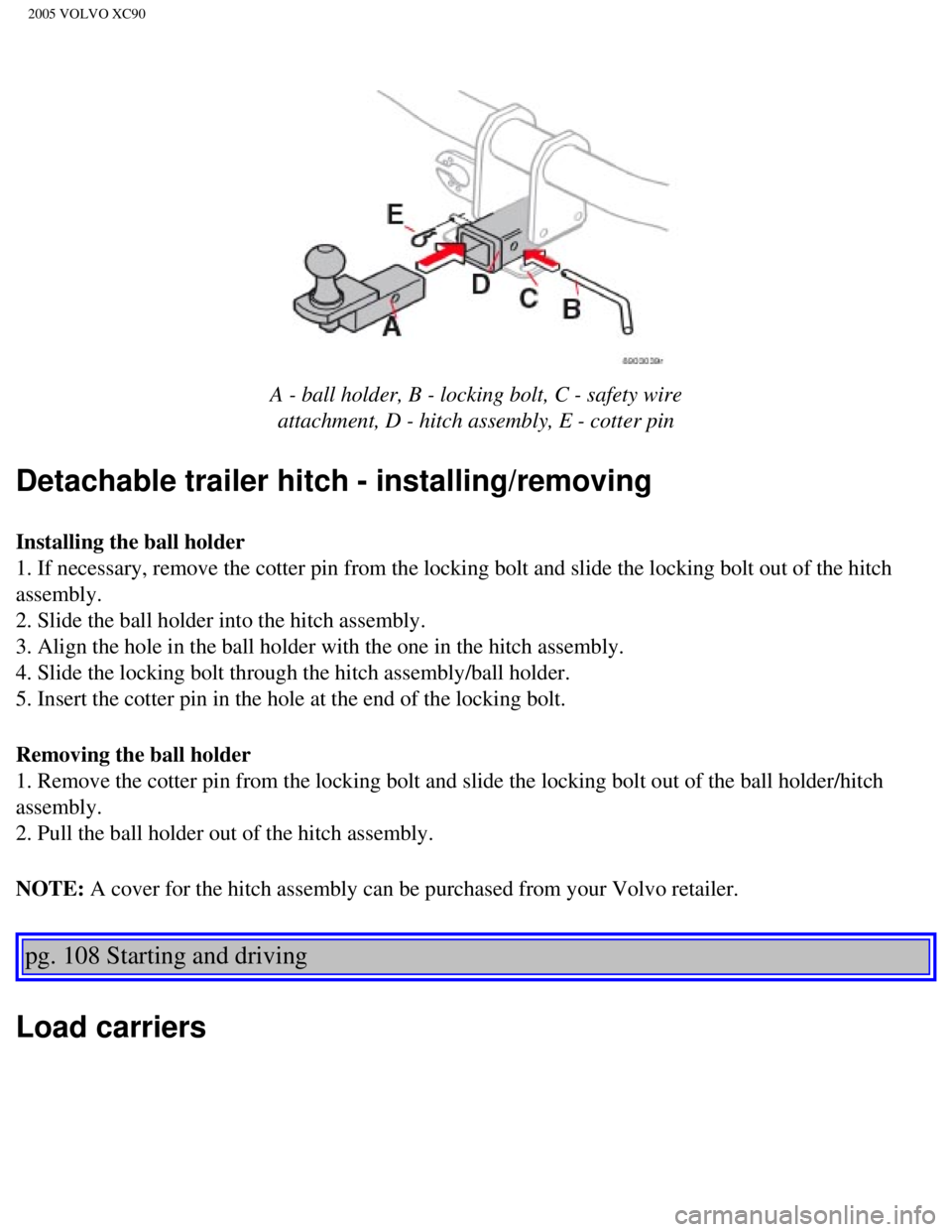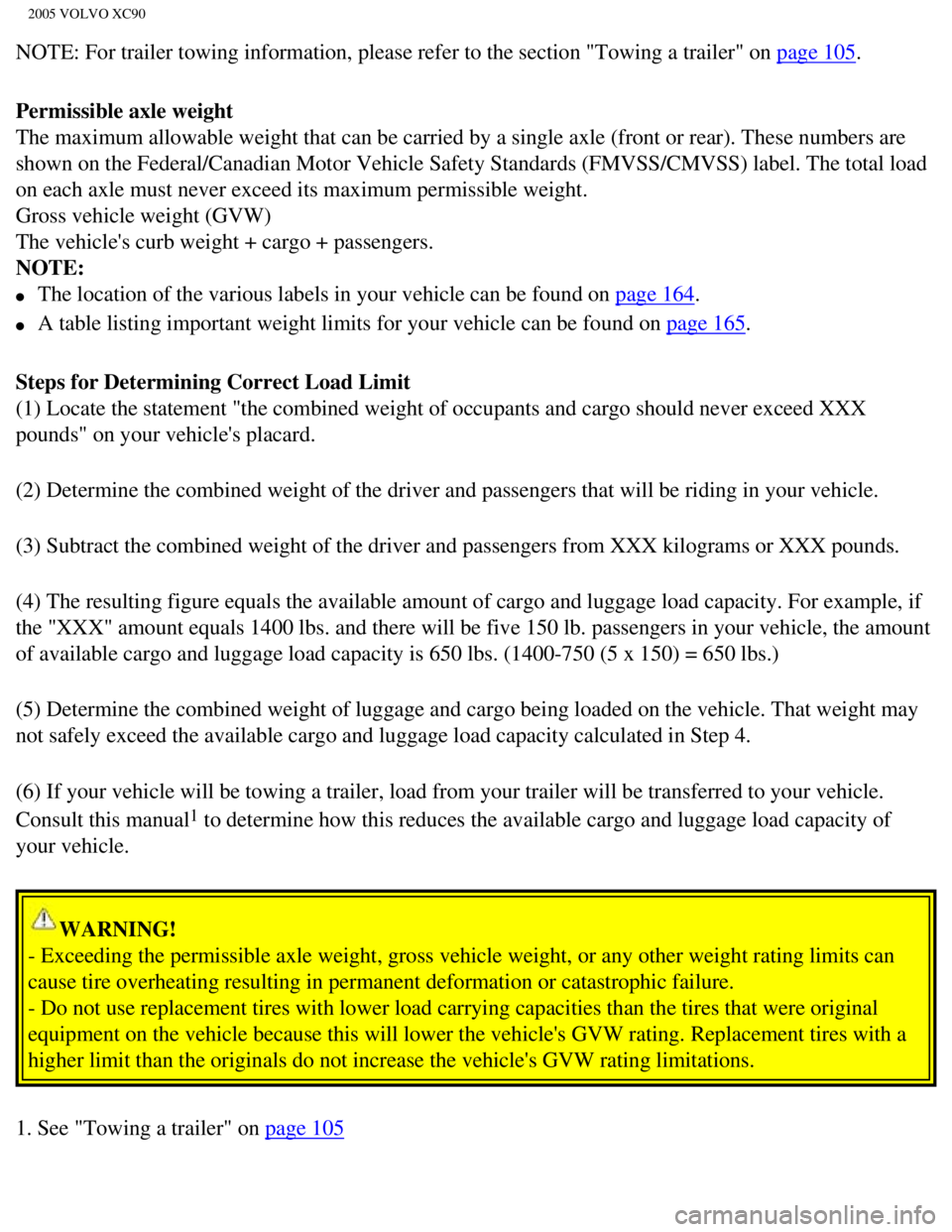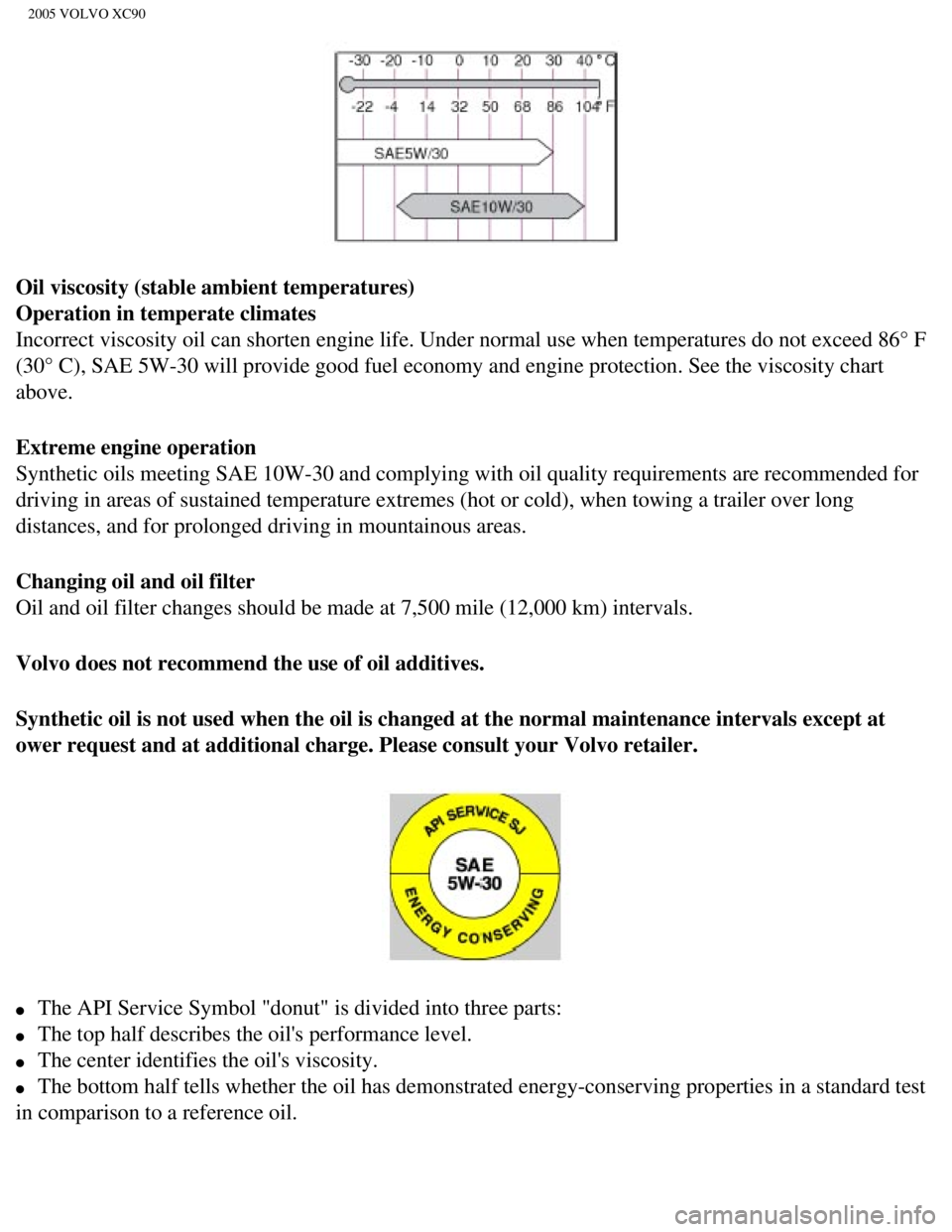2005 VOLVO XC90 trailer
[x] Cancel search: trailerPage 144 of 263

2005 VOLVO XC90
A - ball holder, B - locking bolt, C - safety wire attachment, D - hitch assembly, E - cotter pin
Detachable trailer hitch - installing/removing
Installing the ball holder
1. If necessary, remove the cotter pin from the locking bolt and slide t\
he locking bolt out of the hitch
assembly.
2. Slide the ball holder into the hitch assembly.
3. Align the hole in the ball holder with the one in the hitch assembly.\
4. Slide the locking bolt through the hitch assembly/ball holder.
5. Insert the cotter pin in the hole at the end of the locking bolt.
Removing the ball holder
1. Remove the cotter pin from the locking bolt and slide the locking bol\
t out of the ball holder/hitch
assembly.
2. Pull the ball holder out of the hitch assembly.
NOTE: A cover for the hitch assembly can be purchased from your Volvo retailer\
.
pg. 108 Starting and driving
Load carriers
file:///K|/ownersdocs/2005/2005_XC90/05xc90_06b.htm (14 of 18)12/30/20\
06 4:42:35 PM
Page 164 of 263
![VOLVO XC90 2005 Owners Manual
2005 VOLVO XC90
[43 psi (2.9 bar) for Metric tires]. Increasing the inflation pressure\
beyond this pressure will not increase
the tires load carrying capability.
l kPa: Kilopascal, a metric u VOLVO XC90 2005 Owners Manual
2005 VOLVO XC90
[43 psi (2.9 bar) for Metric tires]. Increasing the inflation pressure\
beyond this pressure will not increase
the tires load carrying capability.
l kPa: Kilopascal, a metric u](/manual-img/45/58559/w960_58559-163.png)
2005 VOLVO XC90
[43 psi (2.9 bar) for Metric tires]. Increasing the inflation pressure\
beyond this pressure will not increase
the tires load carrying capability.
l kPa: Kilopascal, a metric unit of air pressure.
l PSI: Pounds per square inch, a standard unit of air pressure.
l B-pillar: The structural member at the side of the vehicle behind the front door\
.
l Bead area of the tire: Area of the tire next to the rim.
l Sidewall of the tire: Area between the bead area and the tread.
l Tread area of the tire: Area of the perimeter of the tire that contacts the road when mounted \
on the
vehicle.
l Rim: The metal support (wheel) for a tire or a tire and tube assembly upo\
n which the tire beads are
seated.
l Maximum load rating: a figure indicating the maximum load in pounds and kilograms that can \
be
carried by the tire. This rating is established by the tire manufacturer\
.
l Maximum permissible inflation pressure: the greatest amount of air pressure that should ever be
put in the tire. This limit is set by the tire manufacturer.
l Recommended tire inflation pressure: inflation pressure, established by Volvo, which is based on
the type of tires that are mounted on a vehicle at the factory. This inf\
lation pressure is affected by the
number of occupants in the car, the amount of cargo, and the speed at wh\
ich the vehicle will be driven
for a prolonged period. This information can be found on the tire inflat\
ion placard(s) located on the
driver's side B-pillar or on the inside of the fuel filler door on Canad\
ian models, and in the tire inflation
table in this chapter.
l Cold tires: The tires are considered to be cold when they have the same temperatur\
e as the
surrounding (ambient) air. This temperature is normally reached after \
the car has been parked for at least
3 hours.
pg. 120 Wheels and tires
Vehicle loading
Properly loading your vehicle will provide maximum return of vehicle des\
ign performance. Before
loading your vehicle, familiarize yourself with the following terms for \
determining your vehicle's weight
ratings, with or without a trailer, from the vehicle's Federal/Canadian \
Motor Vehicle Safety Standards
(FMVSS/CMVSS) label, and the vehicle's tire information placard:
Curb weight
The weight of the vehicle including a full tank of fuel and all standard\
equipment. It does not include
passengers, cargo, or optional equipment.
Capacity weight
All weight added to the curb weight, including cargo and optional equipm\
ent. When towing, trailer hitch
tongue load is also part of cargo weight.
file:///K|/ownersdocs/2005/2005_XC90/05xc90_08.htm (10 of 17)12/30/200\
6 4:42:37 PM
Page 165 of 263

2005 VOLVO XC90
NOTE: For trailer towing information, please refer to the section "Towin\
g a trailer" on page 105.
Permissible axle weight
The maximum allowable weight that can be carried by a single axle (fron\
t or rear). These numbers are
shown on the Federal/Canadian Motor Vehicle Safety Standards (FMVSS/CMV\
SS) label. The total load
on each axle must never exceed its maximum permissible weight.
Gross vehicle weight (GVW)
The vehicle's curb weight + cargo + passengers.
NOTE:
l The location of the various labels in your vehicle can be found on page 164.
l A table listing important weight limits for your vehicle can be found on\
page 165.
Steps for Determining Correct Load Limit
(1) Locate the statement "the combined weight of occupants and cargo s\
hould never exceed XXX
pounds" on your vehicle's placard.
(2) Determine the combined weight of the driver and passengers that wi\
ll be riding in your vehicle.
(3) Subtract the combined weight of the driver and passengers from XXX\
kilograms or XXX pounds.
(4) The resulting figure equals the available amount of cargo and lugg\
age load capacity. For example, if
the "XXX" amount equals 1400 lbs. and there will be five 150 lb. passeng\
ers in your vehicle, the amount
of available cargo and luggage load capacity is 650 lbs. (1400-750 (5 \
x 150) = 650 lbs.)
(5) Determine the combined weight of luggage and cargo being loaded on\
the vehicle. That weight may
not safely exceed the available cargo and luggage load capacity calculat\
ed in Step 4.
(6) If your vehicle will be towing a trailer, load from your trailer w\
ill be transferred to your vehicle.
Consult this manual
1 to determine how this reduces the available cargo and luggage load capa\
city of
your vehicle.
WARNING!
- Exceeding the permissible axle weight, gross vehicle weight, or any ot\
her weight rating limits can
cause tire overheating resulting in permanent deformation or catastrophi\
c failure.
- Do not use replacement tires with lower load carrying capacities than \
the tires that were original
equipment on the vehicle because this will lower the vehicle's GVW ratin\
g. Replacement tires with a
higher limit than the originals do not increase the vehicle's GVW rating\
limitations.
1. See "Towing a trailer" on
page 105
file:///K|/ownersdocs/2005/2005_XC90/05xc90_08.htm (11 of 17)12/30/200\
6 4:42:37 PM
Page 179 of 263

2005 VOLVO XC90
Oil viscosity (stable ambient temperatures)
Operation in temperate climates
Incorrect viscosity oil can shorten engine life. Under normal use when t\
emperatures do not exceed 86° F
(30° C), SAE 5W-30 will provide good fuel economy and engine protec\
tion. See the viscosity chart
above.
Extreme engine operation
Synthetic oils meeting SAE 10W-30 and complying with oil quality require\
ments are recommended for
driving in areas of sustained temperature extremes (hot or cold), when\
towing a trailer over long
distances, and for prolonged driving in mountainous areas.
Changing oil and oil filter
Oil and oil filter changes should be made at 7,500 mile (12,000 km) in\
tervals.
Volvo does not recommend the use of oil additives.
Synthetic oil is not used when the oil is changed at the normal maintena\
nce intervals except at
ower request and at additional charge. Please consult your Volvo retaile\
r.
l The API Service Symbol "donut" is divided into three parts:
l The top half describes the oil's performance level.
l The center identifies the oil's viscosity.
l The bottom half tells whether the oil has demonstrated energy-conserving\
properties in a standard test
in comparison to a reference oil.
file:///K|/ownersdocs/2005/2005_XC90/05xc90_09a.htm (8 of 14)12/30/200\
6 4:42:39 PM
Page 209 of 263

2005 VOLVO XC90
Fuses in the cargo compartment No. Amperage
1. Backup lights 10A
2. Parking lights, foglights, cargo compartment lighting, license plate \
lights, brake light
diodes 20A
3. Accessories 15A
4. -
5. Rear electronic module 10A
6. Navigation system (option), radio receiver, rear seat entertainment\
(accessory) 7.5A
7. Trailer wiring (30-feed) 15A
8. 12-volt socket in cargo compartment 15A
9. Rear passenger's side door: power window, power window cutout functio\
n 20A
10. Rear driver's side door: power window, power window cutout function \
20A
11. -
12. -
13. -
14. Subwoofer (option), rear air conditioning system (option) 15A
15. -
16. -
file:///K|/ownersdocs/2005/2005_XC90/05xc90_09b.htm (24 of 25)12/30/20\
06 4:42:40 PM
Page 210 of 263

2005 VOLVO XC90
17. Accessory audio5A
18. -
19. Rear window wiper 15A
20. Trailer wiring (15-feed) 20A
21. -
22. -
23. All Wheel Drive 7.5A
24. -
25. -
26. Park assist 5A
27. Main fuse: trailer wiring, park assist, All Wheel Drive 30A
28. Central locking system 15A
29. Driver's side trailer lighting: parking light, turn signal 25A
30. Passenger's side trailer lighting: brake light, fog light, turn sign\
al 25A
31. Main fuse: fuses 37, 38 40A
32. -
33. -
34. -
pg. 162 Maintenance
Fuses (contd)
35. -
36. -
37. Heated rear
window 20A
38. Heated rear window 20A
Contents | Top of Page
file:///K|/ownersdocs/2005/2005_XC90/05xc90_09b.htm (25 of 25)12/30/20\
06 4:42:40 PM
Page 215 of 263

2005 VOLVO XC90
Max. roof load 220 lbs 100 kg
Trailer weight, w/o brakes 1700 lbs 750 kg
Trailer weight, with brakes See the table on
page 105
Max. tongue weight See the table on
page 105
pg. 166 Specifications
Dimensions
Dimensions
Length 188.9 in (479.8 cm)
Width 74.7 in (189.8 cm)
Height 70.2 in (178.4 cm)
Wheelbase 112.5 in (285.7 cm)
Front track 64.3 in (163.4 cm)
Rear track 63.9 (162.4 cm)
Turning
circle 39-40 ft. (11.9-12.3 m)
Cargo capacity
With optional 3rd row of seats folded down:
5-seat: 41.6 cu ft (1178 litres)
7-seat: 43.3 cu ft (1225 litres)
Behind 1st row of seats, with 2nd (and optional 3rd) row of seats fold\
ed down:
5-seat: 84.9 cu ft (2403 litres)
7-seat: 85.1 cu ft (2410 litres)
Behind 1st row of seats, with front passenger seat, 2nd row (and option\
al 3rd row) of seats folded
down:
5-seat: 92.0 cu ft (2606 litres)
7-seat: 93.2 cu ft (2640 litres)
pg. 167 Specifications
file:///K|/ownersdocs/2005/2005_XC90/05xc90_10.htm (5 of 10)12/30/2006\
4:42:41 PM
Page 259 of 263

2005 VOLVO XC90
Text window - messages 30
Three-way catalytic converter
170
TIME FOR REGULAR SERVICE
30
Tire designations
118
Tire inflation
113
Tire inflation pressure table
115
Tire Pressure Monitoring System
29, 116
Tire pressure, checking
113
Tire terminology
119
Tires, changing
124
Tires
112
Towing
102
Towing - cars with All Wheel Drive
103
Towing a trailer
105
Trailer indicator lamp
29
Trailer towing
105
Transmission - Geartronic
93
Tread wear indicator
112
Treble
181
Trip computer
39
Trip odometer
26
Turn signals
35
U
Uniform Tire Quality Grading
128
Unlocking the vehicle
79
Upholstery, cleaning
132
V
Valet key
76
Vanity mirror
66
Vehicle Identification Number (VIN)
164
Vehicle loading
120
VIN (Vehicle Identification Number)
164
file:///K|/ownersdocs/2005/2005_XC90/05xc90_12.htm (10 of 14)12/30/200\
6 4:42:46 PM